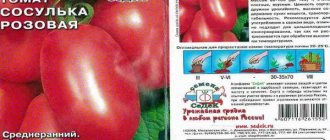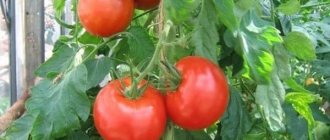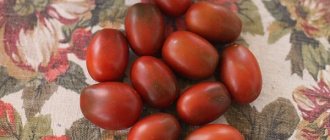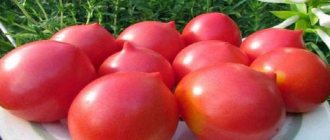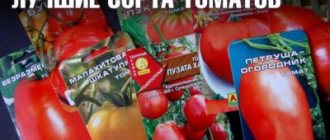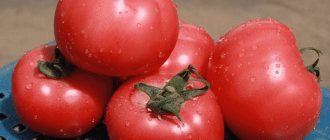The Japanese brush tomato is one of the most mysterious varieties: almost nothing is known about it, and it is very difficult to get seeds. This is due to the fact that the variety is new and has yet to gain a position in the market. However, the characteristics indicate that many gardeners will like it.
| Height | Landing location | Ripening time | Fruit color | Fruit size | Origin | Fruit shape |
| Tall | Greenhouse, Open ground | Mid-season | Reds | Small | Variety | Round |
Description and characteristics of the variety
Siberian Troika tomatoes grow in open ground like semi-standard ones. They reach 60 cm and do not need to be formed, especially since they form few stepsons. But the bush seems to be spreading because of the wide-spread long leaves.
In greenhouses, tomatoes grow in 2-3 stems, the shoots stretch up to 120 cm. They are thick, strong, but without a garter, under the weight of the fruit they can break or lie on the ground.
The Siberian Troika tomato variety differs from others even at the seedling stage. It is not inclined to stretch, compact, strong, with a thick stem.
The leaves are very large, with narrow segments, widely spaced. If they are not standardized, the bush becomes very thick. They seem clumsy, but this is not a disease or imbalance of nutrients, but a varietal feature.
The first fruit cluster is formed after 6-7 leaves. Subsequent ones - after 2-3 internodes. In total, 5-6 brushes grow on the main shoot. The rest of the harvest is taken from the stepchildren.
This tomato should not be confused with the Troika variety (Russian Troika). They are similar – only the name, even the shape of the fruit is different. Often the negative reviews received by the variety actually refer to the Troika created by the agricultural company Aelita.
Description of fruits
The Siberian Troika tomato, the variety description of which calls for the formation of pepper-shaped fruits, actually produces tomatoes of different sizes. They can be elongated, as in the photo. But often on one bush fruits grow that look like peppers, pears or barrels. Each brush, without standardization, contains from 5 to 10 ovaries.
The taste of the fruit is very good, the color is classic red. Like shape, size can vary greatly. The weight of the lower ones reaches 350 g, the length is about 15 cm. On the upper clusters, the tomatoes gradually become smaller, but they only become too small if there is a complete lack of care and unfavorable weather conditions. The pulp is dense, but juicy, with a high sugar content, pinkish when cut. There are few seeds.
The first brushes ripen quite quickly, in the mid-early period. But the pouring of the upper fruits is extended. This is not very good for the Siberian regions. When grown in soil, not all tomatoes have time to ripen. But the brown ones can be ripened indoors, and the green ones can be used in winter salads.
The Siberian Troika tomato is suitable for all types of processing. The first tomatoes are not used for whole-fruit canning - they are too large. But the ovaries from the upper clusters, after ripening, fit perfectly into the jar.
The harvest from one bush is 5 kg. For short tomatoes, especially Siberian ones, this is an excellent result.
Bonsai Micro
The Japanese tomato variety Bonsai Micro f1 is grown for decorative purposes. This is the smallest tomato bush with small but tasty fruits. Plant height 12 cm. Stems are powerful and short. The leaves are wide, fleshy:
- the fruit is round, orange-red, juicy;
- berry weight 15 g;
- experts did not set out to determine the yield of plants, but home growers claim that up to 300 g of fruit can be collected from one bush;
- The variety is hybrid, not affected by pathological microflora.
More on the topic: What is the Eigen F1 tomato?
Bonsai is grown like a regular tomato. For planting, use a 3 liter container. For plants, maintain a temperature of 18-20 C. Branches and leaves on the bush are not cut, axillary shoots are not removed.
For decorative tomatoes, the same fertilizers are introduced as for large-fruited tomatoes. They use superphosphate, fertilizers with humic acids, sapropel, dry mixtures “Rodnichok”, “Organic Mix”.
Correction is carried out if the tops interfere with the ventilation of the soil and fruit. For tomatoes, it is important to organize good lighting.
Characteristics and description of the variety
Hybrid Carpal F1 is classified as early ripening (95-105 days). It can be grown indoors and outdoors in all regions of the Russian Federation. Description of the variety:
- indeterminate bush;
- leaves are medium sized, green;
- simple inflorescences;
- stalks with articulation;
- the fruits are round, with smooth skin and dense pulp;
- the color of green tomatoes is green, ripe tomatoes are red, without a dark spot;
- number of seed chambers – 3-4;
- the taste is good.
The productivity of the hybrid Kisteva in greenhouses under film is 27 kg per 1 sq. m with an average fruit weight of 130-150 g.
Despite the fact that tomatoes have a salad purpose, they can be eaten not only fresh, but also processed and canned.
You can see what a Carpal tomato looks like in the photo above.
Yellow Mimi
The Elou Mimi tomato is included in the State Register of Vegetable Crops. It is zoned in the Moscow, Vladimir, Tula, and Kaluga regions. It is grown in Bryansk, Ivanovo, and Ryazan. This is a cherry tree that is distinguished by its tall growth. Closed ground is recommended for it:
More on the topic: Which tomato varieties are the most productive for a greenhouse?
| № | Helpful information |
| 1 | Japanese tomato bright yellow, round, sweet |
| 2 | weight 16 g; harvest 6 kg/bush |
| 3 | hybrid plant, resistant to viral and fungal infections |
For Yellow Mimi, it is recommended to use mulching film. It retains soil moisture well. In this case, plant care is simplified. Watering is carried out once every 3 weeks.
For tomatoes that are under the film, artificial pollination is used. Ovarian stimulants are used. The inflorescences are irrigated so that the ovary is better formed. Fertilizers that contain potassium, phosphorus, magnesium, and boron are first introduced.
Anti-infection treatments are organized as needed. For tomatoes, fertilizers with mineral complexes are introduced.
Description of tomato Gourmand
The Lakomka tomato variety is the first to ripen in the garden. As practice shows, harvesting can begin 85 days after planting seedlings in open ground. Due to the fact that a distinctive feature of tomato bushes is compactness, you can use a dense planting scheme. Thus, for 1 sq. m you can plant up to 10 bushes, the optimal solution is 6 bushes.
The Gourmand variety grows up to 60 cm in height, as a result of which no work is required to form the bush. Due to the fact that only a small number of leaves grow, it is not necessary to reduce their number. The shape of the bushes is semi-spreading. On each bush, several brushes are formed during the growth process. As a rule, the first brush of a Lakomka tomato variety is located above the 8th leaf, subsequent brushes with an interval of 1-2 leaves.
Description of fruits
A distinctive feature of ripe fruits is their smooth, even round shape. Each fruit weighs approximately 125 g. Ripe fruits attract attention with a rich crimson hue, while the base of the stalk remains dark green; this spot disappears during the ripening process. As a rule, tomatoes grow the same size.
The taste qualities fully correspond to the name - the tomatoes not only ripen early, but are also quite tasty and appetizing. The Gourmand variety has quite dense and fleshy pulp, a delicate, sweet taste. Thanks to their versatility, tomatoes can be used for any purpose - canned, eaten fresh, prepared as first and second courses.
Despite the fact that the skin is very thin, it is quite dense, thanks to which the fruits can withstand treatment with hot water. If necessary, the crop can be transported over long distances without fear of loss of presentation. Since tomatoes have a fairly low density level, they are cut into pieces for canning.
Growing tomatoes
When the soil warms up enough, the tomatoes are planted in the ground. This is usually done in early or mid-June.
Japanese bunch is grown in open ground or in greenhouses. For regions with cold climates, the second option is more suitable.
Planting seedlings in the ground
Tomatoes are planted either in mid-late May or early-mid June. It depends on the climate of the region in which you live. Japanese bunch is a variety that is not highly resistant to temperature changes. Therefore, night frosts can cause the death of fragile plants.
For one sq. m, 3-4 tomato bushes are planted. The crop planting pattern is 30/50 cm.
Ash and compost are poured into the holes in which the tomatoes will be planted. They are also watered generously with warm water.
The seedlings are buried until the first lower leaves. To form additional roots, elongated plants can be planted to a depth of 2-3 leaves.
The tomatoes are watered for the first time 10 days after transplanting the seedlings to a permanent location. During this time, the tomatoes will have time to adapt to new conditions. At the same time, feeding is also done.
Japanese brush is a variety with constant growth. Therefore, it needs gartering and shaping. Form a bush into two stems, this increases the yield.
Stepping is carried out regularly. When pinching, the lower shoots and leaves are removed. It is necessary to remove all wilted and damaged greens. Such manipulations are performed no more than once a week. There is no need to water on the day of planting.
Water the tomatoes once a week. In hot weather, this can be done more often - 2-3 times a week.
Japanese brush tomato bushes require a mandatory garter. For this purpose, special supports are used, for example, wooden planks.
It is important to feed tomatoes regularly. This will increase their yield and speed up the process of fruit set.
Feeding tomatoes:
- Mineral fertilizers. They are applied 2-3 weeks after planting tomatoes in the ground. The first feeding includes superphosphate and potassium sulfate (20 and 15 g per 1 sq. m). The second and third feeding is carried out at the stage of fruit formation. To do this, for 1 sq. m, 15 g of ammonium nitrate and 20 g of potassium sulfate are used.
- You can feed the plants with organic fertilizers . To do this, use a solution of manure fermented with weeds. A mixture of 1 bucket of weeds, 1 bucket of manure and 100 liters of water is prepared. When the mixture ferments, it is diluted at a rate of 1:10.
- Boric acid is used for foliar feeding.
Growing Tips
To get a good harvest, you need to know some of the intricacies of growing tomatoes. Below are the most important of them.
Tips for growing tomatoes:
- It is better to additionally tie heavy tassels with a large number of small fruits to a support. Otherwise, the stalk may break.
- Water the plants only at the roots. This will reduce the likelihood of them being affected by plant diseases.
- Mineral and organic fertilizers are introduced in the form of irrigation. It is important not to get the composition on the greens and plant stems.
- Regular loosening of the soil is necessary for the full growth of tomatoes.
Diseases and pests
The Japanese brush tomato is resistant to blossom end and root rot and tobacco mosaic. The gardener will have to fight other plant diseases.
Pests are collected from tomatoes by hand. There are chemicals that prevent their appearance, but gardeners advise not to use them to obtain a better and healthier harvest.
Careful weeding of the beds will save the plants from mole crickets. For the same purposes, in the autumn, when preparing the bed, eggshells are poured into the soil.
For late blight, Bordeaux mixture is used. You can also use special preparations, for example, Polyazophos or Ditan.
Brown spot can be combated with the help of Fundazol. When signs of powdery mildew appear, spray with Bayleton.
Description of the tomato variety Alsou with photo
Today we will study the Alsou tomato from several sides:
• structure of the bush, • description of the fruits, • other differences of the variety, • features of agricultural technology.
Of course, all this will be accompanied by photographs for greater clarity. It should be noted that the Alsou tomato in different photos may vary greatly. Not only the photos provided by different farmers differ, but also their reviews about this tomato. What is the reason? The thing is that the result is directly dependent on the growing conditions. The slightest deviation from the rules of agricultural technology can lead to weakening of the plant and a decrease in the number and size of fruits.
The structure of the Alsou tomato bush
Alsou is a determinate tomato variety. This means that its growth is limited by the brush, which is formed last. As stated by the manufacturer and confirmed in practice, in open ground the growth of the bush is only 80 cm. In a greenhouse this figure is different and ranges from 1 to 1.5 m.
Farmers note in their reviews that the Alsou tomato has a rather weak trunk, especially in greenhouse conditions. This means that it needs good support. It was also noticed that the bush is covered with a small number of leaves. In the photo you can see the Alsou tomato bush in all its glory.
In the photo there are Alsou tomato bushes
Description of the fruits of the Alsou variety
This point deserves special attention. After all, tomatoes of this variety have an unusually attractive taste. Their pulp is very sweet, juicy, with an average dry matter content. They are not prone to cracking. They can be stored and transported for a relatively long time without loss of quality.
Compared to the fruits of ordinary tomatoes on your plot, the fruits of the Alsou tomato will look like Gullivers in the land of Lilliputians. They can truly be called giants. The fruits that ripen first usually weigh from 600 to 1000 g. The latter, however, are smaller, but, nevertheless, their size is larger than average. Due to these dimensions, the use of tomatoes is limited mainly to the preparation of snacks, salads and juice.
You can see what the fruits look like in the photo below.
Tomatoes of this variety are extremely tasty
Other features of the variety
What other features does the Alsou tomato have, description of the variety, photos, reviews of which are presented in this article?
• It exhibits good disease resistance. • Characterized by high yield - from 7 to 9 kg per square meter. • The Alsou tomato can be successfully grown in almost all climatic zones, both in greenhouses and in greenhouses.
Tomato “Pepper orange” - description, photos of tomatoes, reviews about the variety
I like “Pepper Orange”: this variety successfully combines decent yield, excellent taste and wonderful appearance of tomatoes. Unfortunately, I lost its seeds, and in 2017 I will have to sow purchased ones. It is not a fact that they will turn out to be seeds of the variety indicated on the bag; however, if you’re lucky, new photos and videos about this tomato will appear in the article this summer.
The tomato variety “Pepper Orange” was bred by Valentina Nikolaevna Gubko and Andrei Aleksandrovich Kamanin. Registered in the State Register in 2007 as a variety for amateur gardening and private household plots. The originators are the Research Institute of Cytology and Genetics of the Siberian Branch of the Russian Academy of Sciences and.
Characteristics
| Type | indeterminate |
| Plant height | about 150 cm |
| Fruit | Cylindrical with a run, smooth, weighing up to 200 grams, orange |
| Taste | great |
| Ripening period | mid-season, about 114 days |
| Disease resistance | no evidence |
Description
"Pepper Orange" is an indeterminate tall tomato. The height of the plant is not indicated in the Register. In 2015, it grew quite quickly from the arc greenhouse and would have reached a height of more than 1.5 m, but I pinched the growth point.
The bushes are quite branched, there are many stepsons. Medium-sized leaf, light green: If you plant a Pepper Giant tomato with large dark green leaves next to it, the difference will be clearly visible.
“Orange” has a rather rare intermediate inflorescence with branching. Up to 16 flowers are formed on the inflorescence, but not all form the ovary. In one photo on the Internet, I counted 11 fruits on one hand, but my record was 7.
“Pepper Orange” tomatoes are cylindrical with a run, deep orange in color, very similar to the fruits of sweet peppers. The weight of most fruits is 135...150 grams, some grow more than 200. There are 3 or 4 seed nests, very few seeds. The pulp is medium dense, quite juicy. The taste is excellent.
Features of cultivation
The variety “Pepper-shaped orange” is approved for cultivation in all regions of Russia as a variety for open ground and greenhouses. In general, it grows well in open ground, but in a greenhouse the yield will definitely be greater.
In an article about growing tomato seedlings at home, I wrote a lot about the importance of additional illumination of seedlings, stretching, combating stretching, etc. So, seedlings of this particular variety tolerate a lack of light quite well.
When planting in a permanent place, the optimal density is about 3 plants per square meter. I placed them according to a 70 by 50 cm pattern, and this turned out to be a good solution.
It is imperative to plant tomatoes. In open ground in the middle zone - in one stem, in greenhouses you can leave one brush and a leaf behind it on two side stems. It is necessary to tie them up within a couple of weeks after transplantation: the plants do not support their weight even without fruits.
Characteristics of the variety
Many housewives grow tomatoes of this variety because the plant is very elegant. When the bushes begin to bloom and many flowers appear, there is a feeling that this is an ornamental plant. Tomatoes have a bright pink color that catches the eye. The clusters with fruits independently gather during growth into small clusters, on which tomatoes no more than 5-6 pieces are located.
The weight of one tomato is no more than 150 grams. Their shape is round, similar to a heart, with a pointed tip. There is a small ribbing near the stalk. The description of the fruit indicates that its skin is thin, but at the same time strong, preventing even a very ripe tomato from cracking.
Tomatoes have juicy and at the same time dense pulp. There are few seeds inside, so it is pleasant to eat. They taste sweet, even sugary. The most interesting thing is that even small children can eat Japanese rose tomatoes. They have a high content of sugars and microelements.
As you can see, the characteristics of the Japanese rose are simply excellent and provide food for thought for planting tomatoes in your garden.
Varietal characteristics
Lyubasha is an early determinate hybrid. It takes 70 days from germination to fruit appearance. Fruiting is uniform, 7-8 tomatoes are formed on simple inflorescences. The first brush is laid after the 5th sheet.
Lyubasha tomatoes are resistant to:
- cracking,
- late blight.
When growing a crop with 3 stems and placing 5 plants per 1 m², the yield is:
- 14-15 kg – in a film greenhouse;
- 10-11 kg – in open ground.
Compared to the characteristics and descriptions of other tomato varieties and early hybrids, Lyubasha has a number of advantages; it is easy to grow even for novice gardeners.
Advantages and disadvantages of the “Japanese brush”
The Japanese brush has many advantages :
- high productivity;
- long fruiting;
- great taste;
- good transportability;
- resistance to tobacco mosaic, blossom-end and root rot;
- possibility of growing in open and protected ground;
- versatility of fruit use.
This variety has few disadvantages. These include the need for staking and pinching, instability to temperature changes and immunity to a small number of plant diseases.
Tomatoes Pink Rose
The Pink Rose tomato (hybrid) was developed quite recently; the bushes are indeterminate and have short internodes. On one brush 4 - 6 tomatoes weighing 250 - 270 g are tied. Seedlings can be planted in a greenhouse or in open ground.
Pink Rose has just a huge number of advantages:
- Tomatoes ripen early.
- They tie perfectly even under stress and heat.
- They can easily tolerate heat and go without watering for several days.
- They are immune to major diseases.
- The tomatoes are smooth, round, slightly flattened at the stalk.
- Excellent presentation.
- The skin is dense, so the tomatoes do not crack, are easily transported, and stored for a long time.
- Great sugary taste.
- A characteristic green spot does not appear near the stalk.
- The first shoots are noticeable already on the 2nd day after sowing the seeds.
Pink Rose F1 tomato is very easy to grow. The seedlings take root well after picking and planting on the site. Some vegetables weigh 600 g. Tomatoes can be picked unripe - the fruits ripen easily. One tomato has 6 seed chambers.
You should plant 3 bushes per square meter. A space of 40 cm is made between the plants, and 1 m between the rows. They like the heat; under stress, the tomatoes become larger and tastier.
Growing seedlings
In our country, the crop is planted in open ground or soil in a sprouted and mature form. Planting material is planted in late February - early March. When choosing the time to sow seeds, follow the lunar calendar.
Preparing the seeds
Preparing seeds is an important step in growing seedlings. If done correctly, you will grow healthy plants and get excellent germination rates.
Preparing seeds for sowing:
- Before purchasing seeds, make sure they are not past their expiration date. If using seeds from tomatoes from a previous harvest, this step can be skipped.
- Clean up the planting material. Remove all damaged, black and moldy seeds.
- The seeds are soaked overnight in a light pink solution of potassium permanganate. The floating seeds are removed; they will not germinate. You can treat the seeds by soaking them for 3 hours in a weak solution of hydrogen peroxide.
- The seeds are treated with a growth stimulant. To do this, they are soaked for another night in a special solution (Epin, Zircon or humate, diluted in a ratio of 1: 100) or in water. To do this, they are placed in gauze soaked in a special composition until germination.
A few words about container and soil
Choosing a container is another important step in preparing for growing seedlings. Different containers are used for sowing seeds.
First, all the seeds are sown in one container. Therefore, the first container should be large. Special plastic trays or wooden boxes are suitable for these purposes. You can make containers from scrap materials.
When the plants germinate, they are transplanted into individual pots. For these purposes, small peat containers or plastic cups are used.
The soil is sold in a specialized store. You can prepare the soil mixture yourself by mixing peat and turf soil with humus in equal proportions.
Both purchased and homemade soil need to be treated. To do this, it is poured with a light pink solution of potassium permanganate or calcined in the oven at a temperature of 100 degrees.
Description of tomatoes Nastenka
The tomato variety Nastenka, according to the structure of the bush, belongs to the group of determinate plants that do not require pinching the top. After laying a certain number of flower clusters, the stem stops growing. Nastenka tomato bushes are low - 50-70 cm, stocky, well-leafed. The stem is powerful, but given the large number of fruits and their weight, it is better to tie the plants to a support.
The number of side shoots is small, their growth is limited. Tomato leaves are bright green, small, slightly corrugated. The inflorescences of the variety are simple, with 4-5 flowers each. The first cluster of fruits is formed after 5-6 leaves, and the next ones - at intervals of 1-2 leaves.
Description of fruits
The fruits of the Nastenka tomato variety have a round, noticeably elongated, but not heart-shaped shape. Despite the fact that tomatoes of this variety are early ripening, the fruits on the lower inflorescences are large, weighing up to 250 g. On the upper fruit clusters, the average weight of tomatoes is 120-150 g. Ripened under natural conditions, the fruits of the Nastenka variety have a pleasant pink color, delicate , juicy consistency, sweet taste and delicate aroma. In open ground with insufficient sunny days, the taste may become sour. The surface of Nastenka tomatoes has slightly pronounced ribs, 4-6 seed chambers filled with juice and medium-sized seeds. The skin of the fruit is thin, but quite dense, and tolerates transportation well.
Features of cultivation
Before starting to grow seedlings, you must first soak the tomato seeds in a weak solution of potassium permanganate, after which the seeds are washed in warm water and placed in a dark place for two days. After completing the presented manipulations, you can begin planting the plant.
At first, it is recommended to water the seeds only with warm water.
After the first shoots appear, it is necessary to periodically take the seedlings out into fresh air for hardening. Each time, the amount of time the seedlings spend outside should increase.
After the soil has warmed up, you can begin planting seedlings in open ground:
- At the same time, it is very important to choose a suitable place for growing; it should be well ventilated and not in the shade; partial shade is ideal.
- The distance between the holes in which the tomato bush is placed should be 30-50 centimeters; before placing the tomato bush in the hole, the soil must be thoroughly watered with warm water.
- How deep the hole will be depends entirely on the seedlings; as a rule, the bush should be placed at a depth reaching the first lower leaves, but if the seedlings are very elongated upward, then you can deepen them to 2 or even 3 leaves.
- The stem in the planting hole must be laid carefully in a circle, this will help enhance the growth of the plant’s root system.
- When tomato bushes are planted in the soil, you need to periodically feed them; in this situation, mineral and organic fertilizers, additives, and even humus are most often used.
Description of tomatoes Golden mother-in-law
A determinate hybrid of average height in the garden grows up to 70-80 cm, in a greenhouse up to a meter or slightly higher. The stem is strong and can withstand the load at first with small ovaries, but more often the plant is tied up from the beginning of growth. The tomato has medium leaf density. The leaf blade is large, similar to a potato. Inflorescences are complex. Having created the fifth flower cluster, the plants of the Golden Mother-in-law tomato variety stop growing in stem height. Tomatoes begin to develop fruits that are held tightly in clusters of 3-5 pieces. In the garden, the bushes do without pinching, but in this case they ripen a little later. Typically, tomatoes are ripe 85-90 days after sprouting.
Description of fruits
The tomatoes of the Golden Mother-in-law variety are uniform, round, proportional in shape. Near the stalk, slight ribbing of the beautiful fruits is noticeable. The weight of tomatoes, 8-10 cm in diameter, reaches up to 220 g. Gardeners note the average weight of the fruit of the variety is 100-150 g. The dense skin is smooth, glossy, quite durable, does not crack, and has a bright orange-golden color. The juicy pulp is the same attractive warm color, dense, fleshy. The fruit is divided into 4 chambers, where there are some seeds.
Tomatoes of the Golden Mother-in-law variety are tasty, sweet and sour, and have a pleasant aroma characteristic of the species. Breeders note a high content of beta-carotene in orange fruits, which is 5-7 times higher in this variety than in tomatoes with the usual red flesh.
Description and characteristics of tomato variety Chocolate
The Chocolate tomato is no longer “young”: created by L.A. Myazina, it received registration in the State Register of Breeding Achievements of the Russian Federation back in 2007.
This famous scientist obtained several dozen wonderful varieties and hybrids of tomatoes and a little less cucumbers.
Where can I grow
The variety is intended for personal subsidiary plots and small farms; it grows in open ground. Approved for cultivation in all climatic regions of Russia. At the same time, where tomatoes generally do not grow in open ground, amateurs plant Chocolate tomatoes in greenhouses.
What does a bush look like?
The variety is classified as indeterminate: the plant reaches one and a half meters in height, sometimes more, and requires the mandatory formation of a bush (usually one or two stems) and tying up shoots. The leaves are dark green in color and normal in size.
Chocolate tomato is resistant to most fungal diseases, especially to all types of rot.
The first fruit cluster is formed above the eighth leaf; each cluster contains up to five fruits.
What do the fruits look like?
The fruits are soft, smooth, round in shape, slightly flattened on top and bottom, quite large: on average they weigh about 150 g, and some specimens reach up to 400 g. They contain 4 or more seed nests. In an unripe state, they have the usual green color, and in a state of full ripeness they correspond to the name of the variety: they are colored chocolate. As tomatoes ripen, they turn from green to yellowish, then dark red and finally almost brown. The inside of the tomato is red, and the walls have a transitional color from green to brown. The taste is sweet, rated as excellent, the purpose is almost exclusively salad. Many people say that they have never tasted anything more delicious and exotic.
When to collect and how to use
According to the timing of fruit ripening, the variety is classified as mid-ripening.
Sometimes Chocolate is classified as an early variety, since under optimal conditions the first fruits can be tasted already 3.5 months after sowing the seeds for seedlings.
Tomatoes should not be left on the bushes: many lovers note that overripe Chocolate fruits lose a lot of flavor, become soft, watery, and often crack. However, you shouldn’t pick them green either: when ripened indoors, they don’t gain the taste and aroma that they get on the bushes.
Tomatoes have little shelf life and must be used up or processed within a few days.
Excess harvest can be processed into any product, but the unusual color of the fruit does not allow processing to become a traditional method of using this tomato.
What yield to expect
The yield for the indeterminate variety is low: according to the official document, it is only 4.2 kg/m2. With good care, gardeners receive slightly more fruits; there is even mention of 15 kg/m2, and the creator of the variety also talks about this. Of course, to obtain maximum yields, tomatoes have to “waste away”: in Spartan conditions, the figures given in the State Register of Breeding Achievements of the Russian Federation should be considered more fair.
Video: description of tomato fruits of the Chocolate variety
general characteristics
Japanese dwarf tomatoes are mid-season and determinate. The bush reaches a height of 40-50 cm. Tomatoes grow on it in clusters of 4-6 pieces.
Productivity is from 1 to 2 kg per bush (considering the compactness of the plant, it can be called good, but in comparison with other varieties it is small).
Fruit
The tomatoes are very attractive: bright red, glossy and almost perfectly round. The taste is sweetish with a pleasant sourness. The average weight is 50-60 g, but some specimens reach 70-80 g.
They are quite dense inside. The skin is thin, smooth and durable, does not crack.
The fruits are tasty fresh, suitable for salads and very good for preservation, suitable for making sauces and juices. They fit compactly in the jar and do not burst.
